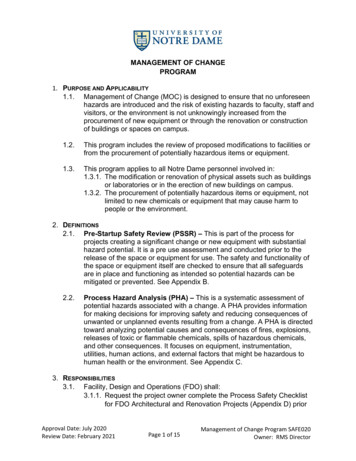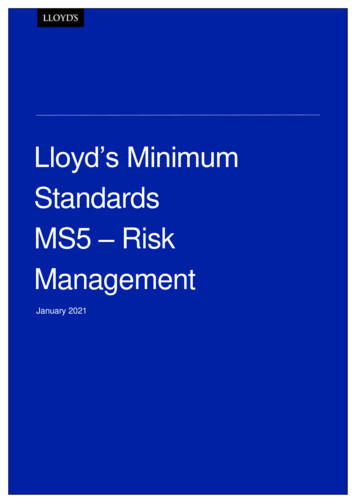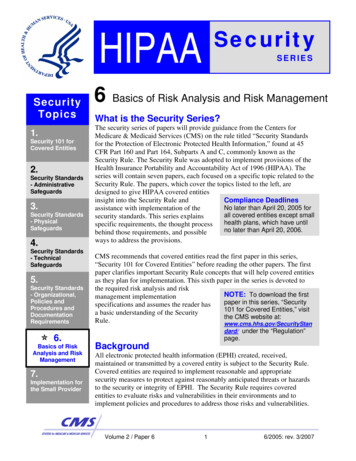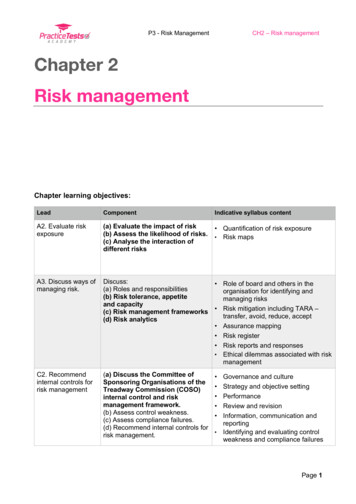
Transcription
MANAGEMENT OF CHANGEPROGRAM1. PURPOSE AND APPLICABILITY1.1. Management of Change (MOC) is designed to ensure that no unforeseenhazards are introduced and the risk of existing hazards to faculty, staff andvisitors, or the environment is not unknowingly increased from theprocurement of new equipment or through the renovation or constructionof buildings or spaces on campus.1.2.This program includes the review of proposed modifications to facilities orfrom the procurement of potentially hazardous items or equipment.1.3.This program applies to all Notre Dame personnel involved in:1.3.1. The modification or renovation of physical assets such as buildingsor laboratories or in the erection of new buildings on campus.1.3.2. The procurement of potentially hazardous items or equipment, notlimited to new chemicals or equipment that may cause harm topeople or the environment.2. DEFINITIONS2.1. Pre-Startup Safety Review (PSSR) – This is part of the process forprojects creating a significant change or new equipment with substantialhazard potential. It is a pre use assessment and conducted prior to therelease of the space or equipment for use. The safety and functionality ofthe space or equipment itself are checked to ensure that all safeguardsare in place and functioning as intended so potential hazards can bemitigated or prevented. See Appendix B.2.2.Process Hazard Analysis (PHA) – This is a systematic assessment ofpotential hazards associated with a change. A PHA provides informationfor making decisions for improving safety and reducing consequences ofunwanted or unplanned events resulting from a change. A PHA is directedtoward analyzing potential causes and consequences of fires, explosions,releases of toxic or flammable chemicals, spills of hazardous chemicals,and other consequences. It focuses on equipment, instrumentation,utilities, human actions, and external factors that might be hazardous tohuman health or the environment. See Appendix C.3. RESPONSIBILITIES3.1. Facility, Design and Operations (FDO) shall:3.1.1. Request the project owner complete the Process Safety Checklistfor FDO Architectural and Renovation Projects (Appendix D) priorApproval Date: July 2020Review Date: February 2021Page 1 of 15Management of Change Program SAFE020Owner: RMS Director
to commencing work. Consult with RMS if safety questions indicatea potential hazard is possible.3.1.2. Partner with RMS to complete the PHA, if needed.3.1.3. Ensure all actions identified from the Process Safety Checklist forFDO Architectural and Renovation Projects (Appendix D) or thePHA are completed prior to project completion.3.1.4. Conduct a PSSR, Appendix B, with RMS and stakeholders prior torelinquishing the building or renovated area.3.2.Procurement Services shall:3.2.1. Include the Procurement Questions within the purchasing system.This is for the purchase of new equipment, radiological sources /lasers, biological agents, and hazardous chemicals (Appendix E).3.2.2. Notify RMS when screening questions warrant a notification.3.2.3. Request the shipper to create a note on the packaging informingWarehouse, Delivery and Transportation (WDT) to notify RMSwhen the equipment arrives. This is only for items or equipmentrequiring further analysis as indicated through the answers in theProcurement Questions (Appendix E) or consultation with RMS.3.3.Risk Management and Safety (RMS) shall:3.3.1. Provide training on procedural elements to Universityrepresentatives as needed or upon request.3.3.2. Participate in or facilitate PHAs.3.3.3. Assist departments with developing mitigation efforts when newequipment or changes are requested.3.3.4. Review and maintain this program commensurate with bestmanagement practices.3.3.5. Conduct triennial program reviews.3.4.University Personnel shall:3.4.1. Use Procurement Services when ordering equipment and completethe Procurement Questions, Appendix E.3.4.2. Contact RMS if receiving purchased items having a note on thepaperwork stating a review is required by RMS or similar.3.4.3. Consult with RMS if questions arise when hazards are noted withthe new equipment or renovated spaces after the completion of theprocurement screening questions, PHA or PSSR.3.5.Warehouse, Delivery and Transportation (WDT) shall:Approval Date: July 2020Review Date: February 2021Page 2 of 15Management of Change Program SAFE020Owner: RMS Director
3.5.1. Inform RMS if receiving an item requiring additional safety analysis.Delivery should not occur until RMS conducts the PSSR orindicates a PSSR is not warranted.4. REQUIREMENTS FOR ORDERING EQUIPMENT (APPENDIX A)4.1. Procurement Services shall be utilized when ordering equipment.4.2.The Procurement Questions (Appendix E) shall be answered reviewingthe equipment’s hazard potential. The purpose of the questions is to notifyRMS of any potentially hazardous equipment so further review can beconducted, if necessary.4.3.RMS shall partner with the individual or group in need of the equipment toensure all safety measures are incorporated prior to delivery of the itemwhen appropriate. When these steps are complete RMS shall release theorder for Procurement to process.4.4.Once the equipment arrives, WDT shall notify RMS. RMS shall conduct aPSSR with the appropriate stakeholders, if necessary. All safetydeficiencies identified during the PSSR, shall be addressed prior to theequipment entering service.5. REQUIREMENTS FOR RENOVATING SPACES OR CONSTRUCTION ACTIVITIES (APPENDIXA)5.1. All renovation and construction projects shall be coordinated with FDO.5.2.The Project Lead shall complete the Process Safety Checklist for FDOArchitectural and Renovation Projects (Appendix D). For low risk projects,construction activities may commence. For higher risk projects, the ProjectLead, RMS and stakeholders shall discuss the need for a process hazardanalysis (PHA). If warranted, the PHA shall be completed prior toconstruction activities commencing (See Appendix C for an examplePHA).5.3.A Pre-Startup Safety Review (Appendix B) shall be conducted with FDO,RMS and the appropriate stakeholders, if deemed necessary. Alldeficiencies shall be addressed prior to the space being released foroperations.6. PRE-START UP SAFETY REVIEW (PSSR)6.1. A PSSR may be warranted:6.1.1. If the proposed new equipment has Procurement Questionsindicating a potential hazard exists. This should be conducted afterthe equipment has arrived. This PSSR shall include a physicalApproval Date: July 2020Review Date: February 2021Page 3 of 15Management of Change ProgramSAFE020Owner: RMS Director
review of the equipment.6.1.2. After the renovation of spaces or construction of buildings. ThePSSR shall include a physical walk through of the building.6.2.Participation in the PSSR6.2.1. PSSRs for new equipment shall include the equipment owner, RMSand others as deemed necessary.6.2.2. PSSRs for renovation projects and new construction shall includeFDO, RMS, the proposed occupant (if identified and appropriate),and others as deemed necessary by any group involved in theproject.7. PROGRAM REVIEW AUDITS7.1. Program Audits – RMS shall conduct triennial reviews of this program and makechanges as indicated during the review.8. RECORD RETENTION8.1Maintain all records per the University of Notre Dame Records Retentionand Disposition Schedule.Procedure Revision TableRevision DescriptionMOC Procedure DevelopedAppendix B – Separated question 12 into question 12and 13.Appendix B – Added question requiring training onnew equipment and or proceduresApproval Date: July 2020Review Date: February 2021Page 4 of 15Date Revision MadeMay 2020January 2021February 2021Management of Change Program SAFE020Owner: RMS Director
Appendix AMOC Program Flow ChartsNew Equipment Flow ChartPurchase of equipmentPurchaser entersrequest throughProcurementEquipment or item placed inserviceProcurement ordersitemPurchaser orProcurement answerscreening hazard / riskquestionsNoScreening questions promptfurther review?YesProcurement informsRMS of hazardous itemRMS contactsPurchaser, gathersadditional informationfor hazard analysisEquipment purchaseraddresses anydeficiencies identifiedNoRMS conducts PSSR.Procurement ordersitemMitigation efforts requiredRMS completes hazardanalysis and documentsreviewYesImplement mitigation orrequire procurement toadd to orderApproval Date: July 2020Review Date: February 2021Page 5 of 15Purchaser teams withRMS to identifymitigation stepsManagement of Change Program SAFE020Owner: RMS Director
Renovation or Building Construction Flow ChartNew Build or RemodelProject leader answerspre-constructionscreening questionsProject entered in BlueBeamProceed with remodelor new buildLow RiskQuestions answers indicatethere is low riskOnce complete conductPre-start, pre-use safetyreviewDeficiencies found duringreview?Risk IDConduct additionalreview as needed, e.g.,process hazard analysisIdentify hazardmitigation andimplementYesCorrect issuesNoNew build,remodelreleased for useApproval Date: July 2020Review Date: February 2021Page 6 of 15Management of Change Program SAFE020Owner: RMS Director
Appendix BPre-Startup Safety Review (PSSR)Description of equipment or space:Location (if applicable)Date of PSSR:Attendees:Establish a team to conduct the PSSR. At least 1 other individual associated with thechange should be involved. Answer each question below by checking Yes, No or N/A.Actions to correct the deficiency must be developed for all questions answered with a“No”. Document the actions and note which items must be completed prior to therelease of the equipment or space to the end user.#1.ItemHas the construction of the project been in accordance withthe design specifications?2. Are the Materials of Construction for all piping, valves,equipment and instruments suitable for the chemical service?3. Has grounding protection been installed?4. Have all new alarms and interlocks been tested as functional?5. Have all Pre-Startup Best Management Practices beenfollowed including, but not limited to: Checking motor rotation. Drying of equipment and piping systems prior tointroducing process chemicals. Integrity and/or leak testing of equipment and piping.6. Was appropriate access to and around the equipmentconsidered?7. Was appropriate room for maintenance & operations workconsidered?8. Are proper escape routes available?9. Are vessels and pipelines labeled i.e., flow direction for piping,HazCom and equipment number for vessels?10. Are Start/Stop buttons, disconnect switches, etc., labeled?Approval Date: July 2020Review Date: February 2021Page 7 of 15YesNoN/AManagement of Change Program SAFE020Owner: RMS Director
#Item11. Are emergency shut-off switches/valves properly marked andlocated so as to be accessible in foreseeable emergencies?12. Are valves, circuit breakers labeled and capable of beinglocked out?13. Are energy control procedures developed and available?14. Is machine guarding appropriate and installed?15. Appropriate provisions provided for material handling?16. Adequate lighting/emergency lighting?17. Safety Showers available, identified and operational? Isdrainage installed?18. Is the installation free of head-knockers and trip hazards?19. Have any necessary safety signs been installed?20. Were Human Factors considerations properly addressed(direction of operation of valves and switches,location/orientation of controls and switches, etc.)?21. Have any identified Industrial Hygiene concerns (exposure tochemicals or noise) been communicated to RMS andaddressed?22. Has area been cleared of debris?23. Have remotely operated valves been checked for properoperation (open/close)?24. Are hoists, ladders (fixed), and lifting devices properlydesigned and installed?25. Has safety equipment been installed as necessary, i.e.,ventilation, emergency stop buttons, fire suppression, fireextinguishers, etc.?26. Have personnel received training on new equipment and / orprocedures?27. OtherYesNoN/AActions to Address DeficienciesAction DescriptionResponsiblePersonTargetDateApproval Date: July 2020Review Date: February 2021Management of Change Program SAFE020Owner: RMS DirectorPage 8 of 15Does Action NeedCompleting Prior toReleasing? Yes or No
Appendix CExample Process Hazard Analysis (PHA)Approval Date: July 2020Review Date: February 2021Page 9 of 15Management of Change Program SAFE020Owner: RMS Director
Appendix CExample Process Hazard Analysis (PHA)Approval Date: July 2020Review Date: February 2021Page 10 of 15Management of Change Program SAFE020Owner: RMS Director
Appendix DProcess Safety Checklist forFDO Architectural and Renovation ProjectsReview and consider the impact on the following. Check Yes, No, or Unsure for eachissue.QuestionGeneral Safety SectionComplete for all ProjectsYesNo UnsureWill this impact emergencypreparedness procedures,including but not limited toemergency egress, occupantloading, etc.?Will this impact emergencyequipment, fire alarms,sprinklers system, etc.?Are there any modified or newconfined spaces?Are there fall protectionrequirements including but notlimited to handrail installation ormodification, roof fall protection,platforms 4’, etc.?Are there fixed ladders?Are there any mezzanines orplatforms?Do walking working surfacesrequire drainage, e.g., drain forsafety shower?Do walking working surfacesrequire slip resistance e.g.,kitchen areas?Will there be equipmentrequiring guarding?Is there a need to labelelectrical disconnects, breakerpanels, etc.?Approval Date: July 2020Review Date: February 2021Page 11 of 15If Yes, provide briefexplanation & page # indrawings, if applicableManagement of Change Program SAFE020Owner: RMS Director
QuestionGeneral Safety SectionComplete for all ProjectsYesNo UnsureWill there be electrical outletsinstalled within 6’ of watersource?Are there any electricallyhazardous areas (Class I, II, orIII)?Will safety showers or eyewashstations be installed?Will emergency lighting beinstalled?Will general or local exhaustventilation to control ahazardous atmosphere (notHVAC) be installed?Are there or will there be anyunderground storage tanks(new or existing)?Will pressure vessels beinstalled or modified in anyway?Will cranes or overhead hoistsbe installed?Will there be a loading dock?Will there be piping or vesselsthat require labeling?Will any high noise ( 85 dBA)equipment be installed ormodified?Will any equipment that emitsatmospheric pollution beinstalled? Consider generators,boilers, etc.?Will there be emergencyshutoffs or interlocks installedon equipment?Approval Date: July 2020Review Date: February 2021Page 12 of 15If Yes, provide briefexplanation & page # indrawings, if applicableManagement of Change Program SAFE020Owner: RMS Director
QuestionEnvironmental SectionComplete for ALL ProjectsYesNo UnsureWill asbestos testing orabatement occur?Will lead testing or abatementoccur?Will mold testing or remediationoccur?If Yes, provide briefexplanation & page # indrawings, if applicableLaboratory SectionComplete for Projects Impacting LaboratoriesQuestionYesNo UnsureIf Yes, provide briefexplanation & page # indrawings, if applicableIs there a need to modify or addventilation such as hoods(chemical, biological, dust,vapors, etc.)?Will a biosafety laboratory beimpacted?Are there any designconsiderations orenhancements for radiationsources or laser use?Will there be any specialsystems installed such aschemical gases deliverysystems for experiments,environmental controls,mechanical equipment forexperiments, etc.?Are there any designconsiderations for animalhandling?Approval Date: July 2020Review Date: February 2021Page 13 of 15Management of Change Program SAFE020Owner: RMS Director
Appendix EProcurement QuestionsPurchase of New Industrial Equipment, Radiological Sources/Lasers, BiologicalAgents or Hazardous ChemicalsIf an item meets any of the criteria listed below, it needs to be reviewed by RiskManagement & Safety, and the check box next to the corresponding Product flag labelis to be clicked. If you are unsure, click the corresponding check box.Equipment:QuestionDoes the item being purchased require any of the following powersources to run?YesNoN/A1. Electricity 220 Volts2. Propane3. Battery, e.g., cars, trucks, SUVs, RVs, marine vehicles,heavy-duty and commercial-use vehiclesIs the item a machine with exposed moving parts?Is the item being procured a crane or a hoist?Is the item a powered industrial truck, such as, but not limited to,fork truck, aerial lift, dump truck, front end loader, etc.?Does the item generate noise 85 dB?Does the item generate off gases, fumes, vapors or anotheratmospheric hazard?Is a contractor required to install or set up the item?Approval Date: July 2020Review Date: February 2021Page 14 of 15Management of Change Program SAFE020Owner: RMS Director
QuestionDoes the item increase the risk of human health exposure tochemicals or release of any materials to the environment?Does the equipment add a new process to the area?Will additional training be required for personnel due to theaddition of this equipment, e.g., fall protection, respiratoryprotection, hearing protection, etc.?Does the installation of the item require any ground penetrations,such as tent stakes or excavation work?Radiological Sources/Lasers:QuestionIs the item radioactive or does it contain radioactive material?Is the item a laser?Biological Agents or Hazardous ChemicalsQuestionIs the item particularly hazardous chemicals as defined by OSHAIs the item a Biological agent (bacteria, fungi, viruses, parasites,recombinant materials), cell lines, blood, select agents, prions?Is it a services for remediation / removal of hazardous chemicalsand wastes, weapons, ammunitionApproval Date: July 2020Review Date: February 2021Page 15 of 15YesNoN/AYesNoN/AYesNoN/AManagement of Change Program SAFE020Owner: RMS Director
5.3. A Pre-Startup Safety Review (Appendix B) shall be conducted with FDO, RMS and the appropriate stakeholders, if deemed necessary. All deficiencies shall be addressed prior to the space being released for operations. 6. P. RE-S. TART . U. P . S. AFETY . R. EVIEW (PSSR) 6.1. A PSSR may be warranted: 6.1.1. If the proposed new equipment has .

![Change Management Process For [Project Name] - West Virginia](/img/32/change-20management-20process-2003-2022-202012.jpg)









